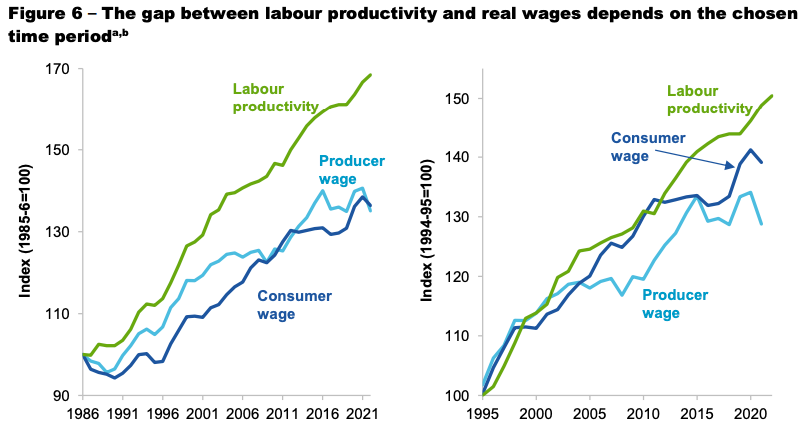
According to the Productivity Commission’s (PC) latest report, Australian employers have taken nearly all of the labour productivity gains of the past five years from workers. The wage price index (WPI) has grown at an average annual rate of just 0.05%, whereas labour productivity has grown 0.96% a year on average.
But pick another wages indicator and the story is slightly brighter for workers: average weekly earnings for all workers have increased 0.52% on average a year for the past five years — just over half of the increase in labour productivity. And it’s a different story over the past decade: labour productivity grew 1.17% annually; WPI at 0.27% annually; all worker earnings at 0.3%. And over the past 20 years, WPI grew at 0.62%, all worker earnings at 1.12% and labour productivity at 1.15%.
So either way, in recent years employers have been taking at least half and perhaps nearly all of the gains given to them by increased worker productivity — even though they’re now attacking workers for not working hard enough.
But why, therefore, are there headlines today in the Financial Review along the lines of “Workers get fair share of pie, says PC as it busts wages myth”? Because the PC report has so many figures and methodologies that the galahs at the AFR, business ideologues and propagandists can cherrypick whatever they like. And that’s what they’ve done.
You’ll find a more accurate account of the report in the Nine tabloids, which actually point out that wages haven’t kept up with productivity growth, but even there you won’t get the whole story, because it’s complicated and requires delving into the appendices that the PC’s otherwise-short paper comes with.
The PC doesn’t use WPI or even all worker earnings to compare labour productivity growth — you have to go to the appendices to find that data. It prefers to use a concept called “producer wages”. Why? “This is because businesses have control over the prices they set and wages they offer; but limited control over the prices people pay for other goods and services. Their capacity to pay wages depends on the prices they receive for their goods and services (rather than the other prices consumers pay).”
Based on that, the PC finds that labour productivity growth has significantly exceeded “producer wages”. By how much? They don’t tell us — because they think that they should remove two sectors where the gap between labour productivity and “producer wages” has grown most quickly — agriculture and mining. And anyway, those two sectors don’t employ many people and are mainly export-focused.
Take out those two — there are eight other industries where productivity grew faster than wages — and the gap between labour productivity growth and producer wages for 95% of the workforce is just 0.12% a year since 1995. If workers had gotten all of their productivity gains, income would be a measly $3000 a year higher now. Incomes would be much higher if we’d maintained our 1990s levels of productivity.
So there you go — the only problem in the economy is low productivity growth, not greedy bosses ripping off workers.
Problem is, no one actually uses producer wages. Not even the AFR’s John Kehoe can go down to the supermarket and offer to pay the “producer wage” price for his trolley of goods. It’s an academic concept. The PC acknowledges this, and actually provides the same results but using “consumer wages”. The gap between labour productivity growth and consumer wages jumps from 0.12% a year to 0.18%, or about $5000 in lost income a year.
And just like the Reserve Bank insisting that we can’t count energy when it comes to profit-driven inflation, the PC is inventing a reason to remove the sectors where labour productivity has far outstripped wages. But what’s the Australian economy without agriculture and mining? Where does our export income, let alone tax revenue and shareholder returns, come from without commodities, energy, iron ore and other minerals?
The PC also acknowledge that if you change the time periods involved, the story about how quickly labour productivity has outstripped wages growth changes significantly. It’s clear that in recent years wages have substantially lagged productivity growth. But looking at data back to the 1980s shows that, whether you use producer or consumer wages, productivity began decoupling from wages in the 1990s, and has never looked back.

So, nothing to see here, says the Productivity Commission. If you take out mining. If you take out agriculture. If you use an abstruse measure of wages, not a real-world one. If you use the right time period.
Who are you going to believe, the Productivity Commission’s economists, or your own lying pay packet?









Thanks for explaining how the PC gets its data to behave itself. It looks like their experts follow a version of some guidance I encountered at university, which included:
I’ve got my own guidance to offer.
It pertains to the construction of guillotines in city squares.
That’s for sure. Lying pricks
Ditto flawed and inflated demographic forecasts, treat supposedly -ve variables of ‘immigration’ via the inflationary ‘NOM’ as flat high constants into the future, while most ignore the potential decline of the same, and also reality of permanent population in decline, to keep up high forecasts; every year more and more retirees with no skin in employment game, unlike the working age, but influential in electoral power and their own interests.
‘The host has to work harder for the parasite to flourish’?
Couldn’t get past that first line, where you abbreviate Productivity Commission to PC.
Was kind of struck by a thunderbolt at that point…
The disparaging term of political correctness (which rather than any progressive folks adopting, I’d suggest they opt for political decency instead) has only ever been applied to the social dimension as far as I’m aware.
How about the economic political correctness of neoliberalism? Surely that’s a strong angle of attack.
Anyway, I’ll actually read the article now
Was listening to one of the galahs, if workers dig up an oval with shovels, it is lower productivity than if they do it with machines. Who’s choice is the method? And how is that reflected in productivity per capita? The machines would undoubtedly be bought from overseas, where they still manufacture. Effing muppets.
‘Productivity’ obsessions, suggesting all should be working ‘harder’.
Absolutely ignores or bypasses qualitative or intangible factors, by design and PR i.e. any ‘numbers’ are supposedly more objective or science based in people’s minds, to support the need for workers to be more efficient e.g. neither unions nor improved award conditions; too easy.
Those stinking dirtbags in their exclusive scum club have been heeded more or less forever, and look where it’s got us. It’s about time we took a bulldozer to their shonky edifice of lies, with so very many runs on the board to tell the tale.
Of course, the bulldozer will have been manufactured somewhere else and we’ll have to get it on AfterPay or some sht, and it’ll break down on the way because it’s only made for the benefit of the shareholders, and we’ll find a locally sourced replacement part, but it arbitrarily contains gratuitous electronics in which the serial number gives the game away that’s not an OEM part so we’ll have to cough up thousands for the Deere John guy to come and punch in a password before we can be on our way, by which time the detective work will have to start from scratch with the shell corporation games…
Labour productivity on its own is a very poor measure which afflicts workers directly but also results in unnecessary capital and other expenditure to “improve” it, thus impacting investors and other stakeholders directly. Capital expenditure nearly always results in the cash flow overseas to Australia’s disadvantage. It results in higher training, health and safety, environmental and social costs which business owners and investors are oblivious to.
Multifactor productivity, on the otherhand, takes into account all input costs but economists are too lazy or ideologically obsessed to address it. The faux science of economics lets us down again.